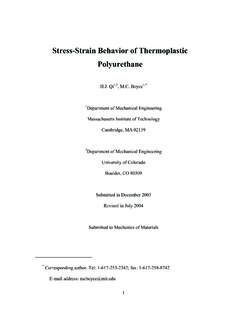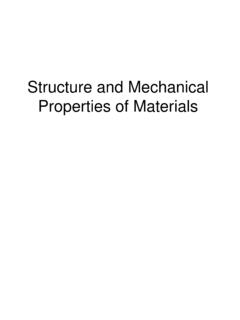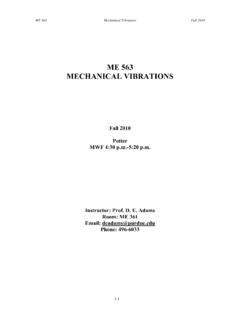Transcription of Thermo-Mechanical Properties of Materials
1 UNESCO EOLSSSAMPLE CHAPTERSCOLD REGIONS SCIENCE AND MARINE TECHNOLOGY - Thermo-Mechanical Properties of Materials - Aleksey V. Marchenko Encyclopedia of Life Support Systems (EOLSS) Thermo-Mechanical Properties OF Materials Aleksey V. Marchenko Professor, The University Centre in Svalbard, Norway Key Words: thermal Properties , thermo -elasticity, deformations, plasticity, yield stress, strength, fracture Contents Properties of Materials Specific heat capacity Thermal conductivity Melting point Latent heat Properties of Materials Young s modulus Poisson s ratio of thermal expansion High Elasticity Properties of Materials stress Yield stress in granular Materials Superplasticity Creep Recrystallization Properties of Materials Ductile and brittle fracture Cold brittleness Hot brittleness Red brittleness Shock viscosity Tensile.
2 Bending and shearing strength Fatigue strength Acknowledgements Glossary Bibliography Biographical Sketch Summary The behavior of real Materials under thermal and mechanical loading is described by a set of physical characteristics, which can be separated conditionally in four groups. The first group of characteristics, including specific heat capacities, thermal conductivity and melting point, describe the behavior of Materials under thermal loading without UNESCO EOLSSSAMPLE CHAPTERSCOLD REGIONS SCIENCE AND MARINE TECHNOLOGY - Thermo-Mechanical Properties of Materials - Aleksey V.
3 Marchenko Encyclopedia of Life Support Systems (EOLSS) relation to their mechanical Properties . The second group of characteristics, including elastic modulus, yield constants, viscosity etc., describes rheological behavior of Materials under mechanical loading without fracture. The third group of characteristics, including density, coefficients of thermal expansion and activation energy, describes Thermo-Mechanical behavior of Materials . The forth group of characteristics describes fracture behavior of Materials .
4 The dependencies of all characteristics from the temperature describe Thermo-Mechanical Properties of Materials . 1. Introduction Thermo-Mechanical Properties of Materials are studied for the prediction of material behavior in wide range of parameters characterizing their internal state (for example, temperature and deformations) and structure (for example, porosity or permeability). Changes of state parameters and structural characteristics of a material are caused by energy exchange and mechanical interaction of a material with environment.
5 Thermo-Mechanical Properties of Materials which study is required for many practical applications are heat capacity, thermal conductivity, rheological Properties , thermal expansion, strength, fracture, freezing point, latent heat, thermal durability, hardness, resistance for abrasion. Heat capacity and thermal conductivity are the main Properties characterizing heat transfer in Materials . Heat capacity characterizes material property to absorb heat energy under the heating and to emit heat energy under the cooling.
6 The amount of heat energy absorbed or emitted under the heating or the cooling of material sample with unit mass over a temperature change of 1oK is called specific heat capacity. Thermal conductivity characterizes material capacity to conduct heat energy under certain temperature gradient. Thermal conductivity is equal to the heat flux through material layer with unit thickness when the temperature of the material on opposite sides of the layer differs by 1oK. Since specific heat capacity and thermal conductivity are related to unit mass and unit volume of a material the density is also comes into the equation defining conductive heat transfer.
7 Rheological Properties of Materials describe relations between internal stresses of Materials and their deformations or strains. Constitutive equations are used to describe rheological Properties quantitatively. Most known rheological Properties are elasticity, viscosity and plasticity. Basically the elasticity assumes that the stresses are proportional to the strains and the work of elastic stresses over closed cycle in stress space is equal to zero. The last property introduces the reversibility of elastic deformations.
8 Physically elasticity is related to the deforming of molecular bonds without their destruction. In the case of small deformations elastic Properties of isotropic material are described by Hook s law, Young s modulus and Poisson s ratio. Hook s law sets up linear dependence between stresses and strains. Young s modulus and Poisson s ratio determine deformations of material in longitudinal and transversal directions in relation to applied load. One dimensional model of elastic material is performed by a spring with stiffness equaling to the Young s modulus (Fig 1a).
9 thermo -elasticity takes into account effects of material deforming under the influence of temperature variations and material heating or cooling under the influence of material deforming. Thermally induced volumetric deformation of isotropic continuum is UNESCO EOLSSSAMPLE CHAPTERSCOLD REGIONS SCIENCE AND MARINE TECHNOLOGY - Thermo-Mechanical Properties of Materials - Aleksey V. Marchenko Encyclopedia of Life Support Systems (EOLSS) proportional to temperature variation with the coefficient of thermal expansion.
10 Viscosity assumes that stresses are proportional to strain rates. Viscous deformations are unbounded and irreversible. All work of viscous stresses is transformed into the heat. Physically viscosity is related to displacements of molecular layers in liquids. In the case of small strain rates of isotropic material the coefficients of rheological equations are reduced to two coefficients: shear and bulk viscosity. The resulting stress and strain-rate relations are linear. One dimensional model of a linear viscous material is performed by a dashpot with certain viscous modulus equaling to the bulk viscosity (Fig.)















